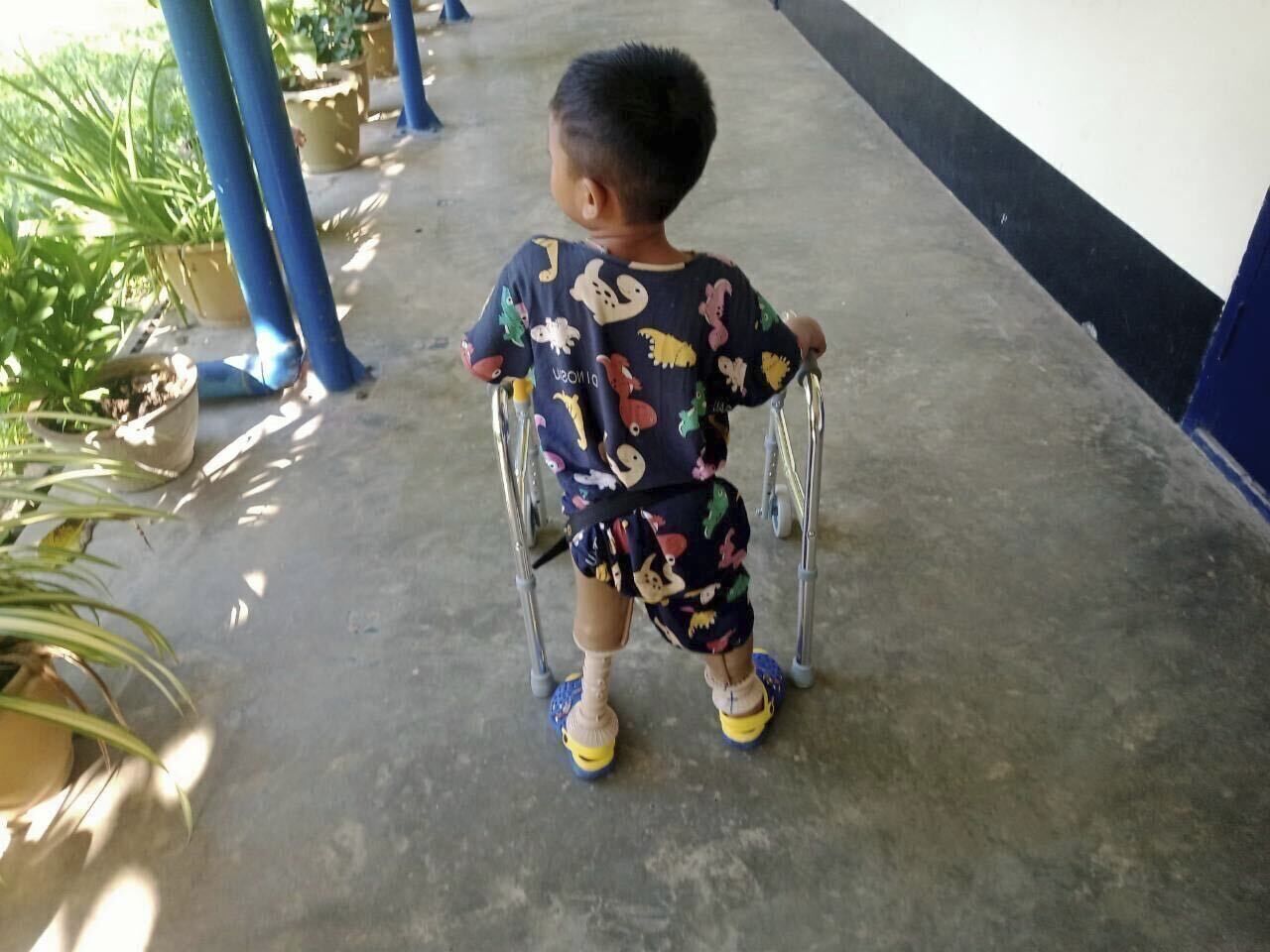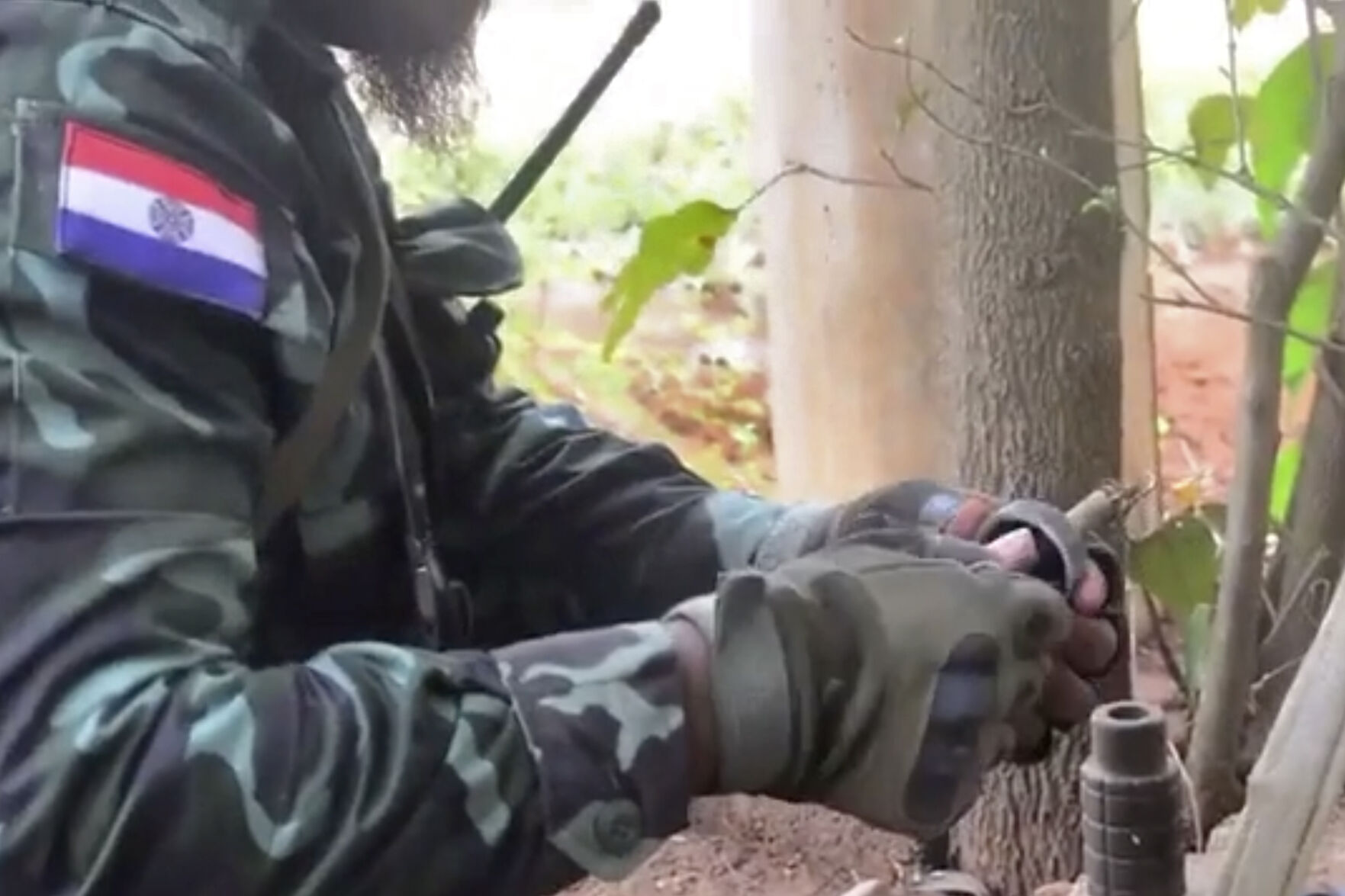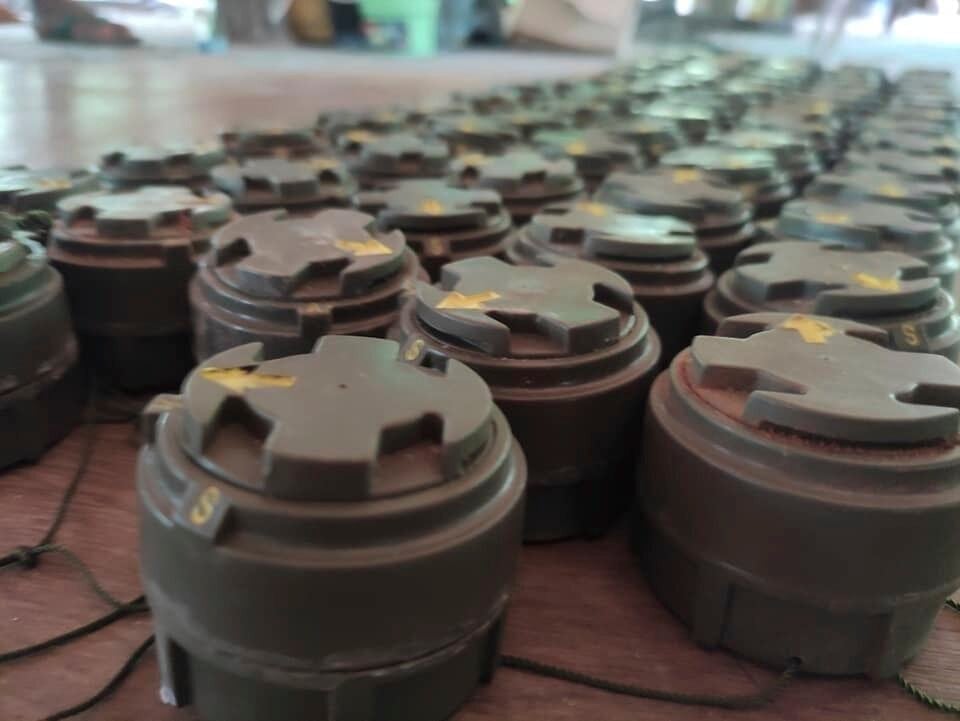BANGKOK — The 3-year-old boy had taken only two steps from his mother’s lap when a deafening explosion rang out. The blast caught the woman in the face, blurring her vision. She forced her eyes open and searched for her son around the jetty where they’d been waiting for a ferry, near their small village in south-central Myanmar.
Through the smoke, she spotted him. His body lay on the ground, his feet and legs mangled with flesh peeled away, shattered bones exposed.
“He was crying and telling me that it hurt so much,” she said. “He didn’t know what just happened.”
But she did.
The boy had detonated a landmine, an explosive device designed to mutilate or destroy whatever comes into its path.

Family photo via AP
A young landmine victim learns to use his new prosthetic limbs on Dec. 7, 2022, at Hpa-An Orthopedic Rehabilitation Center in Hpa-An township, Karen State, Myanmar.
Landmines have been banned for decades by most countries, since the U.N. Mine Ban Treaty was adopted in 1997. But in Myanmar, which isn’t party to the treaty, the use of mines has soared since the military seized power from the democratically elected government in February 2021 and armed resistance has skyrocketed.
Landmines are planted by all sides of the conflict in Myanmar, and they’re responsible for surging civilian casualties, including an alarming number of children as victims, according to an AP analysis based on data and reports from nonprofit and humanitarian organizations, interviews with civilian victims, families, local aid workers, military defectors and monitoring groups.
In 2022, U.N. figures show, civilian casualties from landmine and unexploded ordnance spiked by nearly 40%. Experts say this and other official tallies are vastly undercounted, largely due to difficulties monitoring and reporting during the conflict.
Despite incomplete numbers, experts agree the increase in Myanmar is the largest ever recorded.
Virtually no area is immune to the threat. Over the past two years, mine contamination has spread to every state and region except for the capital city, Naypyitaw, according to Landmine Monitor, a group that tracks global landmine use.

Karenni Nationalities Defense Force
In this image from video provided by a militia operating in the region, a member of the anti-government militia Karenni Nationalities Defense Force (KNDF) deactivates a stake mine on April 22, 2022, which they say was planted by the Myanmar military at the frontline in the Kayah state of Myanmar.
The military also uses civilians as human shields, a practice widespread in the country for decades but raising alarms with increasing mine incidents. AP’s analysis found the military, known as the Tatmadaw, forced people to walk ahead of troops to detonate potential landmines in their path, protecting their own troops.
The Myanmar military, which has acknowledged mine use in the past, didn’t respond to a list of questions AP sent to their official spokesperson’s email.
When the fighting moves on, landmines don’t. Mines left behind can indiscriminately maim or kill those who happen upon them, years later.
It raises the specter of casualties for years to come. In countries including Egypt and Cambodia, people continue to die from millions of mines left behind long after conflicts has ended.
“Leaving an activated mine like this is the same as releasing a monster,” said a 26-year-old military defector who worked as a combat engineer platoon commander in Myanmar.
Like most who were interviewed by AP, the defector spoke on condition of anonymity to protect himself and his family from military retaliation.

Myauk Yamar People’s Defense Force
This photo provided by a militia operating in the region shows landmines that have been removed and collected by a local anti-military militia, the Myauk Yamar People’s Defense Force, on Aug. 19, 2022, in the Salingyi Township of Sagaing region of Myanmar. The group said it was going to reuse them to attack the government army.
Landmines and unexploded ordnance have been a persistent issue in Myanmar for more than four decades. The problem has grown exponentially since the military takeover, with heavier use of landmines in more parts of the country, said Kim Warren, a U.N. landmine specialist.
In 2022, 390 people were victims of landmines and unexploded ordnance in Myanmar, more than a 37% increase from 2021, according to figures compiled by UNICEF. Overall, 102 people were killed and 288 were wounded, with children making up some 34% of the victims, compared with 26% in 2021.
Still, Warren said, incidents are underreported.
Yeshua Moser-Puangsuwan, Landmine Monitor’s Myanmar expert, said his group counts only casualties it can confirm with confidence: “We’ve always been undercounting.”
Experts concede the total number of casualties may seem small, with Myanmar’s population of about 56 million, but say the rapid increase is distressing nonetheless.
Many civilian victims encounter landmines during daily routines, and many of them won’t know who was responsible for the blasts — the Tatmadaw or anti-military groups.
A member of a militia that operates in Sagaing said his group has removed nearly 100 mines thought to be planted by the military and plans to reuse them to augment its arsenal of homemade devices.
“A mine is an indispensable weapon to attack the enemy,” said the member, who spoke by phone on condition of anonymity.
Myanmar and Russia were the only states documented to have used mines in 2022, according to Landmine Monitor.
The group also confirmed the military has been increasingly mining infrastructure such as mobile phone towers and power lines to deter attacks. Military-planted mines also are protecting at least two major Chinese-backed projects — a copper mine in Sagaing and a pipeline pumping station in northeastern Shan state that is part of China’s Belt and Road initiative, Moser-Puangsuwan said.
“We are not aware of the situation you mentioned,” a spokesperson for China’s Ministry of Foreign Affairs wrote to the AP in a fax. “The cooperation project between China and Myanmar is in line with the common interests of both sides and has brought tangible benefits to the people of Myanmar.”
It made no reference to any of those who’d been maimed.
-
‘I just want my legs back’: Myanmar landmine casualties soar
AP FILE, 1948
Jan. 4, 1948: Country then known as Burma gains independence from British colonial rule.
Burma's Prime Minister Thakin Nu takes the oath of office before Burmese President Sao Shwe Thaik, in Rangoon, Jan. 4, 1948.
AP FILE, 1948
Jan. 4, 1948: Country then known as Burma gains independence from British colonial rule.
Burma's Prime Minister Thakin Nu takes the oath of office before Burmese President Sao Shwe Thaik, in Rangoon, Jan. 4, 1948.
-
‘I just want my legs back’: Myanmar landmine casualties soar
AP FILE, 1962
1962: Military leader Ne Win stages a coup and rules the country through a junta for many years.
This Dec. 1, 1962, file photo shows Gen. Ne Win, right, chairman of the Burmese Revolutionary Council, in Rangoon, Burma, now known as Yangon, Myanmar. In March 1962, Gen. Ne Win led a military coup and initiated half a century of military rule that isolated Myanmar, turning it into one of the poorest countries in the world.
AP FILE, 1962
1962: Military leader Ne Win stages a coup and rules the country through a junta for many years.
This Dec. 1, 1962, file photo shows Gen. Ne Win, right, chairman of the Burmese Revolutionary Council, in Rangoon, Burma, now known as Yangon, Myanmar. In March 1962, Gen. Ne Win led a military coup and initiated half a century of military rule that isolated Myanmar, turning it into one of the poorest countries in the world.
-
-
‘I just want my legs back’: Myanmar landmine casualties soar
AP FILE
1988: Aung San Suu Kyi, the daughter of an independence hero, returns to her home country as pro-democracy protests are erupting against the junta. Security forces open fire on demonstrators in August protests, and hundreds are killed.
AP FILE
1988: Aung San Suu Kyi, the daughter of an independence hero, returns to her home country as pro-democracy protests are erupting against the junta. Security forces open fire on demonstrators in August protests, and hundreds are killed.
-
‘I just want my legs back’: Myanmar landmine casualties soar
AP FILE, 1989
July 1989: An increasingly outspoken critic of the junta, Suu Kyi is put under house arrest.
Aung San Suu Kyi is shown in a 1989 file photo wearing a bamboo hat, the election symbol of the opposition National League for Democracy.
AP FILE, 1989
July 1989: An increasingly outspoken critic of the junta, Suu Kyi is put under house arrest.
Aung San Suu Kyi is shown in a 1989 file photo wearing a bamboo hat, the election symbol of the opposition National League for Democracy.
-
-
‘I just want my legs back’: Myanmar landmine casualties soar
AP FILE
May 27, 1990: The National League for Democracy, founded by Suu Kyi, wins a landslide victory in elections, but the military refuses to hand over power.
Burmese voters in traditional dress form a long line, waiting for a voting place to open in Rangoon, May 27, 1990.
AP FILE
May 27, 1990: The National League for Democracy, founded by Suu Kyi, wins a landslide victory in elections, but the military refuses to hand over power.
Burmese voters in traditional dress form a long line, waiting for a voting place to open in Rangoon, May 27, 1990.
-
‘I just want my legs back’: Myanmar landmine casualties soar
AP FILE, 1991
October 1991: Suu Kyi is awarded the Nobel Peace Prize for her peaceful struggle against the regime.
In this Tuesday, Dec. 10, 1991 file photo, Alexander Aris, center, the teenage son of imprisoned Nobel Peace Prize laureate Aung San Suu Kyi, shown in poster at right, accepts the Nobel Peace Prize "in the name of all the people of Burma," from the head of the Norwegian Nobel Peace Prize Committee, Francis Sejersted, left, during the award ceremony in Oslo, Norway. At right is Suu Kyi's son, Kim.
AP FILE, 1991
October 1991: Suu Kyi is awarded the Nobel Peace Prize for her peaceful struggle against the regime.
In this Tuesday, Dec. 10, 1991 file photo, Alexander Aris, center, the teenage son of imprisoned Nobel Peace Prize laureate Aung San Suu Kyi, shown in poster at right, accepts the Nobel Peace Prize "in the name of all the people of Burma," from the head of the Norwegian Nobel Peace Prize Committee, Francis Sejersted, left, during the award ceremony in Oslo, Norway. At right is Suu Kyi's son, Kim.
-
-
‘I just want my legs back’: Myanmar landmine casualties soar
AP FILE, 2010
Nov. 7, 2010: A pro-junta party wins Myanmar's first elections in 20 years, a vote that was boycotted as unfair and rigged in its favor.
In this photo taken Nov. 7, 2010, young Myanmar men pose with mannequin at an entrance of a cloths shop in Yangon, Myanmar.
AP FILE, 2010
Nov. 7, 2010: A pro-junta party wins Myanmar's first elections in 20 years, a vote that was boycotted as unfair and rigged in its favor.
In this photo taken Nov. 7, 2010, young Myanmar men pose with mannequin at an entrance of a cloths shop in Yangon, Myanmar.
-
‘I just want my legs back’: Myanmar landmine casualties soar
AP FILE, 2010
Nov. 13, 2010: Suu Kyi is freed from detention after spending long periods of the past two decades under house arrest.
In this Nov, 13, 2010, file photo, then Myanmar's pro-democracy leader Aung San Suu Kyi talks to the supporters as she stands at the gate of her home in Yangon, Myanmar.
AP FILE, 2010
Nov. 13, 2010: Suu Kyi is freed from detention after spending long periods of the past two decades under house arrest.
In this Nov, 13, 2010, file photo, then Myanmar's pro-democracy leader Aung San Suu Kyi talks to the supporters as she stands at the gate of her home in Yangon, Myanmar.
-
-
‘I just want my legs back’: Myanmar landmine casualties soar
AP FILE, 2012
2012: Suu Kyi wins a by-election and takes her seat in Parliament, holding public office for the first time.
In this June 16, 2012, file photo, Aung San Suu Kyi delivers a speech during the Nobel ceremony at Oslo's City Hall, Norway.
AP FILE, 2012
2012: Suu Kyi wins a by-election and takes her seat in Parliament, holding public office for the first time.
In this June 16, 2012, file photo, Aung San Suu Kyi delivers a speech during the Nobel ceremony at Oslo's City Hall, Norway.
-
‘I just want my legs back’: Myanmar landmine casualties soar
AP FILE, 2015
Nov. 8, 2015: The NLD wins a sweeping victory in general elections that were the first openly held since 1990. The military retained significant power under a constitution that also barred Suu Kyi from the presidency, but the position of state counsellor was created for her to lead the government.
In this Sunday, Nov. 8, 2015, file photo, leader of Myanmar's National League for Democracy party, Aung San Suu Kyi visits a polling station on the outskirts Yangon, Myanmar.
AP FILE, 2015
Nov. 8, 2015: The NLD wins a sweeping victory in general elections that were the first openly held since 1990. The military retained significant power under a constitution that also barred Suu Kyi from the presidency, but the position of state counsellor was created for her to lead the government.
In this Sunday, Nov. 8, 2015, file photo, leader of Myanmar's National League for Democracy party, Aung San Suu Kyi visits a polling station on the outskirts Yangon, Myanmar.
-
-
‘I just want my legs back’: Myanmar landmine casualties soar
AP FILE, 2017
Aug. 25, 2017: Insurgents attack military outposts in the western state of Rakhine, killing dozens. The military responds with a massive crackdown on the Rohingya Muslim population, who begin fleeing by the hundreds of thousands into Bangladesh.
A Rohingya woman and children look at the camera as they sit at a makeshift shelter at Ghumdhum, Cox's Bazar, Bangladesh, Sunday, Aug.27, 2017.
AP FILE, 2017
Aug. 25, 2017: Insurgents attack military outposts in the western state of Rakhine, killing dozens. The military responds with a massive crackdown on the Rohingya Muslim population, who begin fleeing by the hundreds of thousands into Bangladesh.
A Rohingya woman and children look at the camera as they sit at a makeshift shelter at Ghumdhum, Cox's Bazar, Bangladesh, Sunday, Aug.27, 2017.
-
‘I just want my legs back’: Myanmar landmine casualties soar
AP FILE, 2019
Dec. 11, 2019: Suu Kyi defended the military in a case at the International Court of Justice in The Hague, denying it had committed genocide.
AP FILE, 2019
Dec. 11, 2019: Suu Kyi defended the military in a case at the International Court of Justice in The Hague, denying it had committed genocide.
-
-
‘I just want my legs back’: Myanmar landmine casualties soar
AP FILE, 2020
Nov. 8, 2020: Myanmar holds elections, with the NLD capturing an outright majority in Parliament.
In this Nov. 8, 2020, file photo, Myanmar military Commander-in-Chief Senior Gen. Min Aung Hlaing leaves a polling station after voting in Naypyitaw, Myanmar.
AP FILE, 2020
Nov. 8, 2020: Myanmar holds elections, with the NLD capturing an outright majority in Parliament.
In this Nov. 8, 2020, file photo, Myanmar military Commander-in-Chief Senior Gen. Min Aung Hlaing leaves a polling station after voting in Naypyitaw, Myanmar.
-
‘I just want my legs back’: Myanmar landmine casualties soar
AP FILE, 2021
Jan. 29, 2021: Myanmar's election commission rejects the military's allegations of fraud in the elections, finding no evidence to support the claims.
In this Jan. 30, 2021, file photo, supporters of the Myanmar military and the military-backed Union Solidarity and Development Party hold placards as they continue to protest election results during a rally near Shwedagon pagoda in Yangon, Myanmar.
AP FILE, 2021
Jan. 29, 2021: Myanmar's election commission rejects the military's allegations of fraud in the elections, finding no evidence to support the claims.
In this Jan. 30, 2021, file photo, supporters of the Myanmar military and the military-backed Union Solidarity and Development Party hold placards as they continue to protest election results during a rally near Shwedagon pagoda in Yangon, Myanmar.
-
-
‘I just want my legs back’: Myanmar landmine casualties soar
AP FILE, 2021
Feb. 1, 2021: Myanmar military takes control of the country for one year, citing the government's failure to act against its claims of voter fraud and refusal to postpone the November elections because of the coronavirus crisis. Her party says Suu Kyi is again placed under house arrest.
Soldiers sit inside trucks parked on a road in Naypyitaw, Myanmar, Monday, Feb. 1, 2021. Myanmar military television said Monday that the military was taking control of the country for one year, while reports said many of the country's senior politicians including Aung San Suu Kyi had been detained.
AP FILE, 2021
Feb. 1, 2021: Myanmar military takes control of the country for one year, citing the government's failure to act against its claims of voter fraud and refusal to postpone the November elections because of the coronavirus crisis. Her party says Suu Kyi is again placed under house arrest.
Soldiers sit inside trucks parked on a road in Naypyitaw, Myanmar, Monday, Feb. 1, 2021. Myanmar military television said Monday that the military was taking control of the country for one year, while reports said many of the country's senior politicians including Aung San Suu Kyi had been detained.



